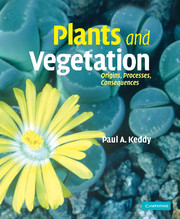Book contents
- Frontmatter
- Contents
- Preface
- Acknowledgements
- Chapter 1 Plants and the origin of the biosphere
- Chapter 2 Description of vegetation: the search for global patterns
- Chapter 3 Resources
- Chapter 4 Stress
- Chapter 5 Competition
- Chapter 6 Disturbance
- Chapter 7 Herbivory
- Chapter 8 Positive interactions: mutualism, commensalism, and symbiosis
- Chapter 9 Time
- Chapter 10 Gradients and plant communities: description at local scales
- Chapter 11 Diversity
- Chapter 12 Conservation and management
- Questions for Review
- References
- Index
- References
Chapter 2 - Description of vegetation: the search for global patterns
- Frontmatter
- Contents
- Preface
- Acknowledgements
- Chapter 1 Plants and the origin of the biosphere
- Chapter 2 Description of vegetation: the search for global patterns
- Chapter 3 Resources
- Chapter 4 Stress
- Chapter 5 Competition
- Chapter 6 Disturbance
- Chapter 7 Herbivory
- Chapter 8 Positive interactions: mutualism, commensalism, and symbiosis
- Chapter 9 Time
- Chapter 10 Gradients and plant communities: description at local scales
- Chapter 11 Diversity
- Chapter 12 Conservation and management
- Questions for Review
- References
- Index
- References
Summary
Two ways of sorting plants into groups: phylogeny and function. Phylogenetic classification: Linnaeus, Bentham, Hooker, Wallace, Darwin, Bessey. Molecular systematics. Asteraceae, Orchidaceae. Takhtajan. Functional classification: von Humboldt, Raunkiaer, Küchler. Classification of climate: the Köppen system. Synthesis: ecoregions.
Introduction
Some 2 billion years of plant life have made the Earth what it is today: a planet with an atmosphere composed largely of nitrogen and oxygen. Only trace amounts of carbon dioxide remain. Most carbon is now locked into organic molecules in living organisms (mainly plants, mostly cellulose) or as part of the liquid or solid remains of earlier life forms (petroleum and coal, respectively). Of all of the above-ground organic carbon present in living organisms, 99.9 percent is stored in plants (Whittaker 1975). The rest of the Earth's biota, including insects, birds, reptiles, amphibians, and mammals, comprises a mere 0.1 percent of the carbon pool. This living organic carbon is spread in a thin layer over the Earth's surface – thinnest in deserts and thickest in forests.
To proceed further with the scientific analysis of vegetation, it is necessary to subdivide this vast pool of organic carbon into categories. Two basic approaches for subdivision exist, the phylogenetic and the functional, and they can be both contradictory and complimentary. The phylogenetic approach aims to sort plants into groups sharing a common evolutionary history – early work used traits such as floral morphology, more recent work uses direct measurement of similarity in gene structure.
- Type
- Chapter
- Information
- Plants and VegetationOrigins, Processes, Consequences, pp. 35 - 62Publisher: Cambridge University PressPrint publication year: 2007



